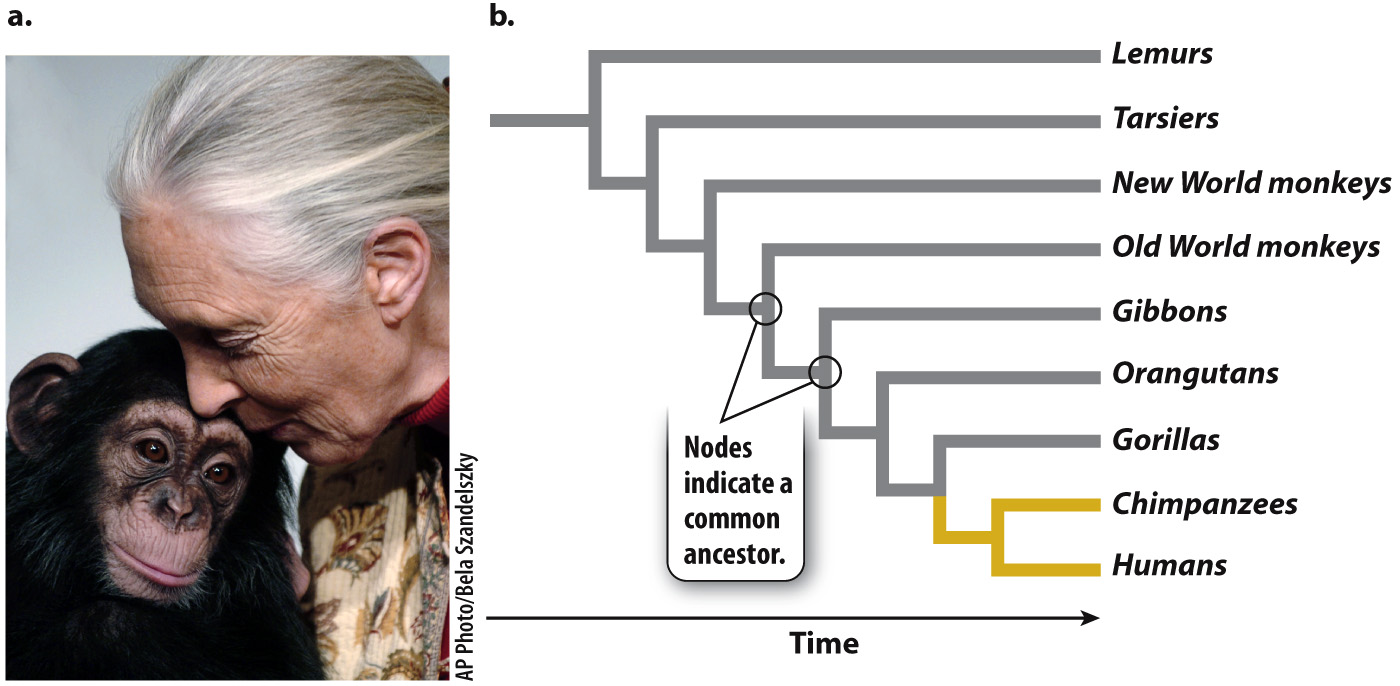Evolution predicts a nested pattern of relatedness among species, depicted as a tree.
Evolutionary theory predicts that new species arise by the divergence of populations through time from a common ancestor. As a result, closely related species are likely to resemble each other more closely than they do more distantly related species. You know this to be true from common experience. All of us recognize the similarity between a chimpanzee’s face and body and our own (Fig. 1.16a), and biologists have long known that we share more features with chimpanzees than we do with any other species.

Humans and chimpanzees, in turn, share more features with gorillas than they do with any other species. And humans, chimpanzees, and gorillas share more features with orangutans than they do with any other species. And so on. We can continue to include a widening diversity of species, successively adding monkeys, lemurs, and other primates, to construct a set of evolutionary relationships that can be depicted as a tree (Fig. 1.16b). In this tree, the tips or branches on the right represent different groups of organisms, nodes (where lines split) represent the most recent common ancestor, and time runs from left to right.
Evolutionary theory predicts that primates should show a nested pattern of similarity, and this is what morphological and molecular observations reveal. We can continue to add other mammals and then other vertebrate animals to our comparison, in the process generating a pattern of evolutionary relationships that forms a larger tree, with the primates confined to one limb. And using comparisons of DNA among species, we can generate still larger trees, ones that include plants as well as animals and the full diversity of microscopic organisms. Biologists call the full set of evolutionary relationships among all organisms the tree of life.
This tree, illustrated in Fig. 1.17, has three major branches representing the three domains mentioned earlier and is made up mostly of microorganisms. The last common ancestor of all living organisms, which form a root to the tree, is thought to lie between the branch leading to Bacteria and the branch leading to Archaea and Eukarya. The plants and animals so conspicuous in our daily existence make up only two branches on the eukaryotic limb of the tree.

The tree of life makes predictions for the order of appearance of different life-
Shared features, then, sometimes imply inheritance from a common ancestor. In combination, molecular studies such as comparisons of DNA sequences and fossils show that the close similarity between humans and chimpanzees reflects descent from a common ancestor that lived about 6 million years ago. Their differences reflect what Darwin called “descent with modification”—evolutionary changes that have accumulated over time since the two lineages split. For example, as discussed in Chapter 24, the flat face of humans, our small teeth, and our upright posture all evolved within our ancestors after they diverged from the ancestors of chimpanzees. At a broader scale, the fundamental features shared by all organisms reflect inheritance from a common ancestor that lived billions of years ago. And the differences that characterize the many branches on the tree of life have formed through the continuing action of evolution since the time of our earliest ancestors.
Four decades ago, the geneticist Theodosius Dobzhansky wrote, “Nothing in biology makes sense except in the light of evolution.” For this reason, evolution permeates discussions throughout this book, whether we are explaining the molecular biology of cells, how organisms function and reproduce, how species interact in nature, or the remarkable biological diversity of our planet.